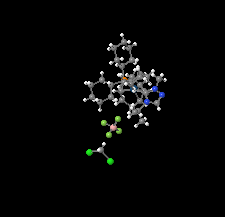issue contents
July 2022 issue

Cover illustration: [(1,2,5,6-η)-Cycloocta-1,5-diene](4-isopropyl-1-methyl-1,2,4-triazol-5-ylidene)(tricyclohexylphosphane-κP)iridium(I) tetrafluoridoborate dichloromethane monosolvate, [Ir(C8H12)(C6H11N3)(C18H33P)]BF4·CH2Cl2, a triazole-based N-heterocyclic carbene iridium(I) cationic complex with a tetrafluoridoborate counter-anion, crystallizes with one dichloromethane solvent molecule per formula unit. The IrI atom of the cationic complex has a distorted square-planar coordination environment, defined by a bidentate cycloocta-1,5-diene (COD) ligand, an N-heterocyclic carbene, and a tricyclohexylphosphane ligand. The complex crystallizes in a C-centered monoclinic unit cell and has an unusually high number of eight formula units. See:Rushlow, Astashkin, Albert & Rajaseelan [IUCrData (2022). 7, x220685].
inorganic compounds


 access
access

 access
accessmetal-organic compounds


 access
accessorganic compounds


 access
access

 access
access

 journal menu
journal menu
















![[publCIF]](/logos/authorchecklist11.gif)





